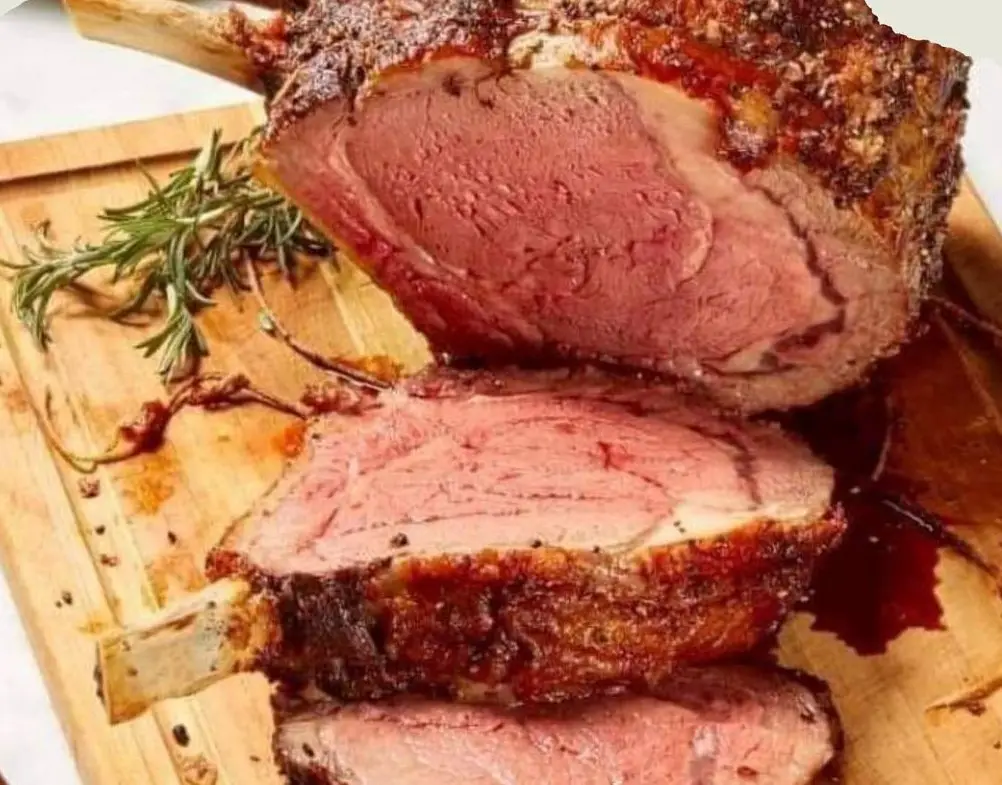Prime rib roast is a classic and indulgent dish that’s perfect for special occasions and gatherings. Its succulent flavor and tender texture make it a favorite among meat lovers. This prime rib recipe promises to deliver a mouthwatering dish that will impress your guests and leave them craving for more.
Ingredients:
- 1 bone-in prime rib roast (6-8 pounds)
- 2 tablespoons olive oil
- Salt and pepper, to taste
- Garlic cloves, optional
Directions:
- Preheat Your Oven: Begin by preheating your oven to 500°F (260°C). This high initial temperature will help to sear the outside of the prime rib, sealing in juices and creating a flavorful crust.
- Prepare the Roast: Place the prime rib roast on a rack in a roasting pan. Drizzle the roast with olive oil, ensuring it is evenly coated. Season generously with salt and pepper, covering all sides of the roast. If you desire extra flavor, you can insert garlic cloves into the roast using a paring knife.
- Initial Roasting: Place the roasting pan with the prime rib into the preheated oven and roast for 15 minutes. This initial high-heat cooking will help to develop a savory crust on the exterior of the roast.
- Continue Roasting: After 15 minutes, reduce the oven temperature to 325°F (160°C). Continue roasting the prime rib until it reaches your desired level of doneness. It’s essential to use a meat thermometer to monitor the internal temperature of the roast. For medium-rare, aim for an internal temperature of 135°F (57°C). For medium, it should be 140°F (60°C). For those who prefer well-done, target an internal temperature of 150°F (66°C).
- Rest Before Serving: Once the prime rib reaches the desired temperature, remove it from the oven and allow it to rest for 15-20 minutes. This resting period allows the juices to redistribute within the meat, ensuring a juicy and tender final product.
Tips:
- For the best results, choose a high-quality prime rib roast with good marbling for maximum flavor and tenderness.
- Let the roast come to room temperature before cooking to ensure even cooking throughout.
- Use a meat thermometer to avoid overcooking or undercooking the prime rib.
- Customize the seasoning according to your taste preferences by adding herbs or spices to the rub.
Conclusion:
This prime rib recipe is a surefire way to elevate any gathering or special occasion. With its simple yet flavorful seasoning and precise cooking instructions, you’ll be able to achieve a perfectly cooked prime rib roast that is juicy, tender, and bursting with flavor. Serve it alongside your favorite sides and enjoy a memorable meal with family and friends.
- How do I select the best prime rib roast for this recipe?
- When choosing a prime rib roast, look for one with even marbling throughout the meat. Marbling refers to the thin streaks of fat within the muscle tissue, which contribute to tenderness and flavor. Select a roast that is well-trimmed with a good layer of fat on the outside, as this helps to keep the meat moist during cooking. Additionally, consider the size of the roast based on the number of servings you require and the size of your oven.
- Why is it essential to let the prime rib rest after cooking?
- Allowing the prime rib to rest after cooking is crucial for several reasons. Firstly, it allows the juices within the meat to redistribute, ensuring that each slice remains moist and flavorful. If you were to cut into the roast immediately after cooking, the juices would escape, resulting in a drier final product. Secondly, resting the meat allows the internal temperature to even out, preventing hot spots and ensuring that each slice is cooked to perfection. Finally, resting gives you time to prepare any accompanying side dishes or sauces, allowing for a well-coordinated meal.
- Can I adjust the cooking time and temperature for a smaller or larger prime rib roast?
- Yes, you can adjust the cooking time and temperature based on the size of your prime rib roast. For smaller roasts, you may need to reduce the initial cooking time at 500°F (260°C) to avoid overcooking the exterior. Conversely, for larger roasts, you may need to extend the cooking time at the lower temperature to ensure thorough cooking. It’s essential to use a meat thermometer to monitor the internal temperature of the roast and adjust the cooking time accordingly. Remember, the ultimate goal is to achieve your desired level of doneness while ensuring that the meat remains juicy and tender.
- What are some recommended side dishes to serve with prime rib?
- Prime rib pairs well with a variety of side dishes that complement its rich flavor and hearty texture. Traditional accompaniments include creamy mashed potatoes, roasted vegetables such as carrots, Brussels sprouts, or asparagus, and a flavorful gravy made from the pan drippings. You can also serve a fresh green salad or steamed greens for a lighter option. Consider incorporating bread rolls or Yorkshire pudding to soak up the delicious juices from the roast. Ultimately, the choice of side dishes depends on your personal preferences and the occasion for which you are serving the prime rib. Experiment with different combinations to create a memorable and satisfying meal for your guests.

